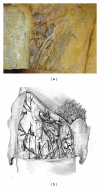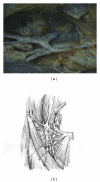Anatomic aspects of inguinal lymph nodes applied to lymphadenectomy in penile cancer
- PMID: 22110493
- PMCID: PMC3205725
- DOI: 10.1155/2011/952532
Anatomic aspects of inguinal lymph nodes applied to lymphadenectomy in penile cancer
Abstract
Objectives. To provide a better understanding of the distribution of inguinal nodes in order to prevent the complications of unnecessary and extended dissections in penile cancer. Methods. The bilateral inguinal regions of 19 male cadavers were dissected. Nodal distribution was noted and quantified based on anatomical location. The superficial nodes were subdivided into quarters as follows: superomedial, superolateral, inferomedial, and inferolateral. Statistical analysis was performed comparing node distribution between quarters using one-way analysis of variance (ANOVA), and the unpaired T-test was used between superficial and deep nodes. Results. Superficial nodes were found in all inguinal regions studied (mean = 13.60), and their distribution was more prominent in the superomedial quarter (mean = 3.94) and less in the inferolateral quarter (mean = 2.73). There was statistical significance between quarters when comparing the upper group with the lower one (P = 0.02). Nodes were widely distributed in the superficial region compared with deep lymph nodes (mean = 13.60 versus 1.71, P < 0.001). Conclusions. A great number of inguinal lymph nodes are distributed near the classical anatomical landmarks for inguinal lymphadenectomy, more prominent in upper quadrants.
Figures




Similar articles
-
Long-term followup of penile carcinoma with high risk for lymph node invasion treated with inguinal lymphadenectomy.J Urol. 2010 Jun;183(6):2227-32. doi: 10.1016/j.juro.2010.02.025. J Urol. 2010. PMID: 20399455
-
Robotic inguinal lymphadenectomy for penile cancer: the why, how, and what.Transl Androl Urol. 2017 Oct;6(5):826-832. doi: 10.21037/tau.2017.06.05. Transl Androl Urol. 2017. PMID: 29184779 Free PMC article. Review.
-
Anatomical characterization of the inguinal lymph nodes using microcomputed tomography to inform radical inguinal lymph node dissections in penile cancer.J Surg Oncol. 2020 Dec;122(8):1785-1790. doi: 10.1002/jso.26199. Epub 2020 Sep 10. J Surg Oncol. 2020. PMID: 32914446
-
Lymphadenectomy in the surgical management of penile cancer.Eur Urol. 2009 May;55(5):1075-88. doi: 10.1016/j.eururo.2009.02.021. Epub 2009 Feb 23. Eur Urol. 2009. PMID: 19264390 Review.
-
[Cancer of the penis: the value of systematic biopsy of the superficial inguinal lymph nodes in clinical N0 stage patients].Prog Urol. 1993 Apr;3(2):228-33. Prog Urol. 1993. PMID: 8508206 French.
Cited by
-
Long-term follow-up of comparative study of open and endoscopic lymphadenectomy in patients with penile carcinoma.Surg Endosc. 2024 Jan;38(1):179-185. doi: 10.1007/s00464-023-10542-8. Epub 2023 Nov 10. Surg Endosc. 2024. PMID: 37950029 Free PMC article.
-
Modification of N staging systems for penile cancer: a more precise prediction of prognosis.Br J Cancer. 2015 May 26;112(11):1766-71. doi: 10.1038/bjc.2015.141. Epub 2015 May 5. Br J Cancer. 2015. PMID: 25942394 Free PMC article.
-
Comparing Outcomes of Open and Robot-Assisted Inguinal Lymphadenectomy for the Treatment of cN2 Squamous Cell Carcinoma of the Penis: A Retrospective Single-Center Analysis.Cancers (Basel). 2024 Nov 22;16(23):3921. doi: 10.3390/cancers16233921. Cancers (Basel). 2024. PMID: 39682110 Free PMC article.
-
Penile Cancer: The Importance to predict lymph node metastasis.Int Braz J Urol. 2016 Nov-Dec;42(6):1056-1057. doi: 10.1590/S1677-5538.IBJU.2016.06.01. Int Braz J Urol. 2016. PMID: 27813379 Free PMC article. No abstract available.
-
A laparoscopic radical inguinal lymphadenectomy approach partly preserving great saphenous vein branches can benefit for patients with penile carcinoma.BMC Surg. 2022 Apr 9;22(1):138. doi: 10.1186/s12893-022-01582-3. BMC Surg. 2022. PMID: 35397549 Free PMC article.
References
-
- Pizzocaro G, Algaba F, Horenblas S, et al. EAU penile cancer guidelines 2009. European Urology. 2010;57(6):1002–1012. - PubMed
-
- Burgers JK, Badalament RA, Drago JR. Penile cancer: clinical presentation, diagnosis, and staging. Urologic Clinics of North America. 1992;19(2):247–256. - PubMed
-
- Favorito LA, Nardi AC, Ronalsa M, Zequi SC, Sampio FJB, Glina S. Epidemiologic study on penile cancer in Brazil. International Brazilian Journal of Urology. 2008;34(5):587–591. - PubMed
-
- Culkin DJ, Beer TM. Advanced penile carcinoma. Journal of Urology. 2003;170(2 I):359–365. - PubMed
-
- Ornellas AA, Seixas ALC, Marota A, Wisnescky A, Campos F, De Moraes JR. Surgical treatment of invasive squamous cell carcinoma of the penis: retrospective analysis of 350 cases. Journal of Urology. 1994;151(5):1244–1249. - PubMed
LinkOut - more resources
Full Text Sources

